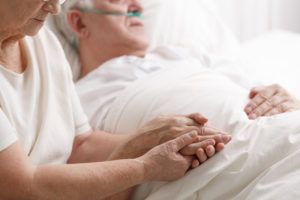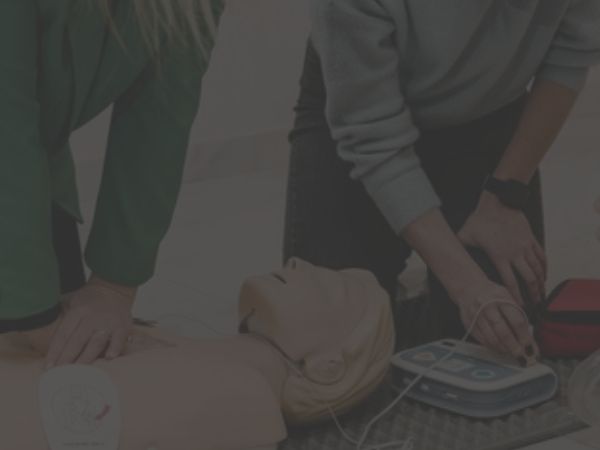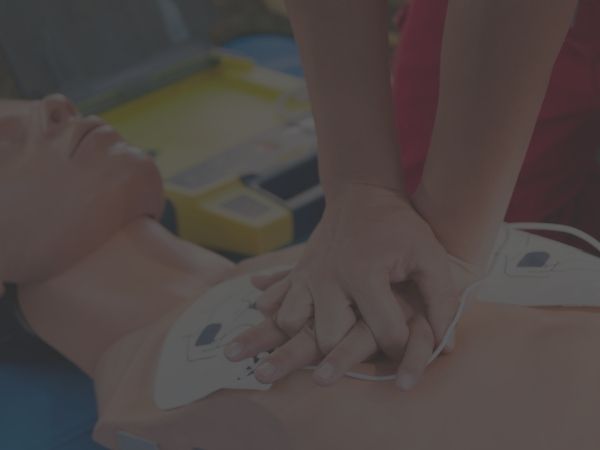Your cart is currently empty!
Best Practices: ACLS Algorithm Standards for POST-CA Care
 According to NIH.gov, in the United States, nearly 300,000 adults experience an in-hospital cardiac arrest, according to NIH.gov. Their average age is probably younger than you think — 66 years old.
According to NIH.gov, in the United States, nearly 300,000 adults experience an in-hospital cardiac arrest, according to NIH.gov. Their average age is probably younger than you think — 66 years old.
Cardiac arrest in the hospital is caused by a problem with the heart itself 50%-60% of the time. But another 15%-40% result from respiratory arrest. While Advanced Cardiac Life Support (ACLS) can get the heart beating again, a shockingly low number of those resuscitated make it to discharge — only about 17-20%.
For this reason, what happens next in post-cardiac arrest care is critical. What does the ACLS algorithm (heartcode) say about post-cardiac care, and what difference can it make in survival rates?
What Determines Survival Rate to Discharge
Several factors have been shown to increase the survival rate. Some of these are out of the control of medical professionals caring for the patient. But they’re important to note.
According to the Journal of American Medical Association, people with the worst shot at surviving to discharge are those with pulseless electrical activity (PEA) Those with asystole and bradycardia had a slightly higher chance. Advanced age was also a factor, as those 70 and older had only an 18.5% chance of surviving compared to 45% for adults 69 and younger.
Those who need atropine or who were on diuretics before the event also experienced a lower chance of making it to discharge.
A Swedish study of over 5000 patients found that certain factors increased survival rate:
- Ventricular tachycardia or ventricular fibrillation is the first recorded rhythm.
- If the person had an out-of-hospital cardiac arrest, someone started bystander CPR
- Conscious on admission
- Sinus rhythm on admission
- Treatment with lidocaine in the ER / ED
How Are Best Practices for Post-CA Determined?
Each year, the respected organization International Liaison Committee on Resuscitation (ILCOR) conducts research and reviews mounds of real-world data to establish which best practices demonstrate scientifically that they can save lives and preserve function. As new information becomes available, and clinical studies establish new and better ways to manage cardiac care, ILCOR updates its guidelines.
With permission, Save-A-Life takes the standards established by ILCOR and creates easy-to-follow algorithms, megacodes, free training courses training videos, study guides, an app, and certification programs for both professionals and laypeople to learn and practice these best practices.
The below best practices come from the ACLS certification program Adult Immediate Post-Cardiac Arrest Care Algorithm and Adult Immediate and the ACLS Certification program’s Post-Cardiac Arrest Care lesson based upon these standards.
Objectives for Post-Cardiac Care
Once the return of spontaneous circulation (ROSC) is achieved through Advanced Cardiac Life Support, medical professionals face the challenge of taking appropriate steps to ensure that this person not only survives but also retains as much brain function as possible. Quality of life matters, after all. It should certainly be a goal.
Regardless of why the cardiac arrest happened, multiple organs may have been affected, so caring for these organs so that they do not also fail is critical. Medical professionals will need to attempt to:
- Identify what caused the cardiac arrest and promptly address it
- Keep the heart stable. Atrial fibrillation is common after ROSC and can be fatal.
- Maintain airways and optimize oxygenation while preventing hyperoxia (over-oxygenation)
- Use Percutaneous Coronary Intervention
- Provide other neurologic care
- Among other patient-dependant strategies
All of this requires integrated post-cardiac care. When these interventions happen according to the ACLS algorithm, both short-term and long-term survival rates rise, as demonstrated in a 2016 study and continue to be shown in hospitals everywhere.
Identifying and Addressing Reversible Causes
One of the first goals of post-cardiac arrest care is to identify why the heart stopped in the first place. Reversible causes of cardiac arrest you’ll need to explore include:
- Hypovolemia – Low fluid outside the cell walls, which may be due to electrolyte imbalance or blood loss.
- Hypoxia – Low blood oxygen
- H+ (acidosis) – High hydrogen presence in the extracellular fluid accompanied by low serum bicarbonate levels
- Hypothermia
- Hypo or Hyperkalemia – Low or high potassium in the blood
- Cardiac tamponade – Fluid buildup around the heart
- Toxins – Exposure to a poison
- Tension pneumothorax – Air trapped in the pleural cavity under pressure displacing structures and impacting cardiac function
- Thrombosis (pulmonary or coronary) – Blood clot in the vessel leading to the lung or heart respectively
Therapeutic Hypothermia
Therapeutic Hypothermia is a common treatment for people who have had a cardiac arrest. Rescuers may initiate it during cardiac arrest or immediately after. It involves using cooling devices to lower the body temperature temporarily to around 89° to 93° F for around 24 hours.
The heartcode recommends this treatment for people who are in a coma but have recently experienced a return of spontaneous circulation (ROSC).
Why Is This Treatment Effective?
 According to HopkinsMedicine.org, lack of blood flow during a cardiac arrest causes severe and often irreparable damage to the brain. Many who have had a cardiac arrest may experience ROSC but never regain consciousness. Lowering the body temperature (within reason) can reduce the brain damage experienced. It has been shown to increase the chance of them waking up.
According to HopkinsMedicine.org, lack of blood flow during a cardiac arrest causes severe and often irreparable damage to the brain. Many who have had a cardiac arrest may experience ROSC but never regain consciousness. Lowering the body temperature (within reason) can reduce the brain damage experienced. It has been shown to increase the chance of them waking up.
Cooling works by lowering inflammation in the brain, which in excess can make the damage already incurred by the stopping of the heart worse.
What Are the Risks of Therapeutic Hypothermia?
Most medical procedures have both benefits and risks. This one is no exception. Although complications caused directly by this procedure are rare, they may include:
- Developing an abnormal heart rhythm, usually a slow heartbeat (bradycardia) rather than atrial fibrillation (a rapid heartbeat)
- Sepsis (a severe blood infection)
- The inability of the blood to clot could increase internal bleeding if present
- Electrolyte and metabolic problems
- Raised blood sugar levels
- Doctors will typically wait three days to assess brain function to determine if Therapeutic Hypothermia reduced the progression of brain damage.
Optimization of Ventilation
After ROSC, you must continue to manage the airway. This may include early placement of an endotracheal tube if not already intubated.
You’ll start at 10 breaths a minute but may need to adjust this to achieve SpO2 between 92 and 98% and a PaCO2 of 35-45 mmHg.
In the early stages of treatment, 100% oxygen is beneficial as it can reduce the damaging effects of hypoxia (low blood oxygen) on the brain and other organs. However, over a longer period, this can lead to hyperoxygenation (over oxygenation) which also speeds up CO2 removal from the body.
CO2 removal is, of course, an important function of the respiratory system. However, fast removal can cause the arteries to constrict. This, in turn, reduces the oxygen getting to the left side of the heart. It can also lower coronary perfusion pressures which maintain sufficient blood pressure.
For this reason, we call this “optimization” — finding the balance between the two extremes.
The ACLS algorithm begins with a sidebar reminding you of the importance of ventilation optimization and how to achieve it with 10 to 12 breaths per minute. It also advises you to titrate to target PACO2 (Partial pressure of carbon dioxide) 35-45 mmHg.
Oxygen Titration
Oxygen titration allows you to maintain an O2 saturation of about 94%, which is high enough to prevent hypoxia, but low enough to ensure you that hyperoxygenation is not occurring.
IV Fluids
At this point, the ACLS algorithm also suggests that you keep the patient on IV fluids, which can restore and balance electrolyte levels that become imbalanced when the heart stops. These and vasoactive medications should be monitored and adjusted to achieve hemodynamic stability.
The ACLS algorithm lists these as follows:
- IV Bolus: 1 to 2 liters of normal saline or Lactated Ringer’s (a crystalloid fluid)
- Epinephrine IV infusion: 0.1 to 0.5 mcg/kg/minute
- Dopamine IV infusion: 5 to 10 mcg/kg/minute
- Norepenephrine: 0.1 to 0.5 mcg/kg/minute (same as epinephrine)
Optimization of Hemodynamic Parameters
When managing the hemodynamic parameters, your goal is:
- Systolic > 90 mmHg
- Mean arterial pressure > 65 mmHg
12-Lead ECG
Staff should obtain a 12-lead ECG to get the most comprehensive picture of what’s happening in the heart.
Depending on what the 12-lead ECG reveals, you might need to perform an emergency cardiac intervention if:
- Experiencing STEMI symptoms – chest pain due to shortness of breath with nausea vomiting or diaphoresis (excessive sweating)
- Unstable cardiogenic shock – inadequate blood flow due to ventricular dysfunction
- Need for mechanical circulatory support
Percutaneous Coronary Intervention (PCI)
Percutaneous coronary intervention (PCI) (aka angioplasty/stent) is preferred over thrombolytic, even though there is still some debate among experts. The stent should generally be placed within 12 hours, according to Science Direct.
Placing a stent post-cardiac arrest has been shown to drastically improve survival rate, although factors like advanced age and co-morbidities can significantly impact how well PCI works to increase survival.
Thrombolytic meds, the less preferred method, involved the use of clot-dissolving medicines to bust up clots.
If a person has a cardiac arrest outside the hospital, ACLS heartcode dictates that EMS should take the person to a facility that can perform PCI. If a center only has Thrombolytic capabilities, the patient should be transferred.
Comatose Vs Awake Post-Cardiac Arrest Care Per Heartcode
If the person is comatose, you’ll continue with:
- TTM – Targeted temperature management (as discussed above)
- Brain CT to verify brain activity
- EEG monitoring – to watch for irregular rhythms and other cardiac warning signs
- Other standard critical care management
If the patient is awake, you’ll continue with standard critical care procedures.
Neurological Care
A neurological assessment is critical. While medical professionals see the three-day mark evaluation as the most telling, monitoring and evaluation is an ongoing process.
The first neurological decision is when to withdraw care due to brain death. It’s important to note that false positives can occur. People do come back from a documented brain death. And it seems to defy logic. But in line with Occam’s Razor, the simplest explanation is most often the correct one. Humans are fallible and medical devices made by humans can also fail us from time to time. Assessments should be checked and rechecked before withdrawing care.
When available, a neurological specialist should be there to monitor neurologic signs during this post-resuscitation period.
Psychological Care for Patients, Family, and Professionals
It’s critical that medical professionals not forget the human side of cardiac arrest. Often there is a family waiting for word, feeling hopeful of full recovery, only to be let down when the patient doesn’t make it to discharge.
While knowing this doesn’t change how you treat each and every patient, it certainly adds an aspect to treatment — your mental health and wellbeing included.
Just as families and the patient (if conscious) need clear and compassionate communication, so does the rescue team. We know that statistically speaking, despite these efforts, most patients will not survive to discharge. That’s a lot to carry.
The post-cardiac arrest ACLS heartcode recommends “After a resuscitation, debriefing for lay rescuers, EMS providers, and hospital-based healthcare workers may be beneficial to support their mental health and well-being.”
You can also support your mental and emotional well-being by preparing for events like these. For example, you can practice an ACLS megacode in fictional but common scenarios you may encounter. Scenarios include:
- Ventricular fibrillation
- Subventricular tachycardia
- Stroke
- Pulseless Electrical Activity (PEA)
- ST-Elevation Myocardial Infarction
- PALS for pediatric patients
Now, you’ll feel more prepared to manage the stress surrounding resuscitation and post-cardiac arrest care.
Following ACLS Saves Lives
There’s no question about it. When medical professionals apply ACLS best practices they save lives. Effective medical teams Get ACLS Certified, so they’re all on the same page and can work together seamlessly to preserve life and quality of life in their patients.
ACLS certifications through Save A Life are Joint Commission Compliant and can earn you CME credits as a medical professional. To learn more about Post-CA care and other advanced cardiac care topics, we encourage you to explore our free online resources. Share your wisdom and thoughts in the comments below, or head on over to the discussion about this post on Facebook.










Leave a Reply